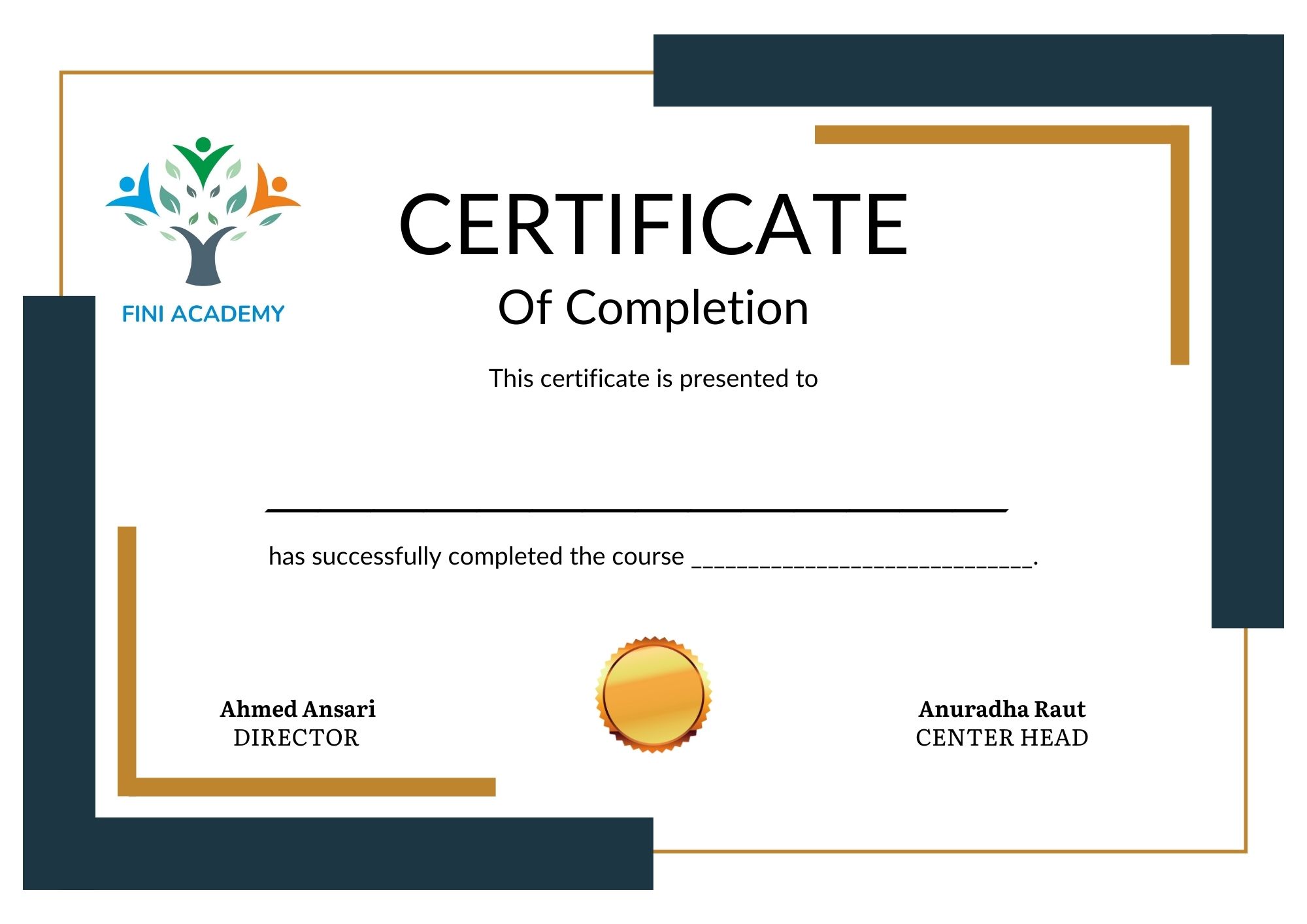- +91 90280 94499
- info@finiacademy.com
- info.finiacademy@gmail.com
 An Automated Testing course teaches you how to write and run tests to ensure software quality, covering frameworks like JUnit or Selenium, types of testing (unit, integration, etc.), and best practices for automating and maintaining tests in development workflows.
An Automated Testing course teaches you how to write and run tests to ensure software quality, covering frameworks like JUnit or Selenium, types of testing (unit, integration, etc.), and best practices for automating and maintaining tests in development workflows.
The objective of an Automated Testing course is to equip participants with the skills and knowledge to design, develop, and implement automated testing frameworks. It aims to enhance efficiency in software testing by automating repetitive tasks, ensuring better test coverage, faster execution, and improved accuracy. The course focuses on various testing tools, scripting languages, and methodologies that enable testers to identify bugs early in the development cycle, ultimately improving software quality and reducing the time to market.
An Automated Testing course provides an overview of techniques and tools used to automate the process of software testing. It typically covers various types of testing like unit, integration, and system testing, and how they can be automated using tools such as Selenium, JUnit, and TestNG. The course teaches the creation of test scripts, managing test environments, and integrating testing into continuous integration pipelines. The goal is to improve software quality and efficiency by reducing manual testing efforts and ensuring consistent, repeatable tests.
Module 1 : Java Basics
 Installing Java
Installing Java Installing Eclipse
Installing Eclipse First Eclipse Project
First Eclipse Project First Java program
First Java program Concept of class file
Concept of class file Datatypes in Java
Datatypes in Java String class and functions
String class and functions Conditional Statements
Conditional Statements Loops
Loops Arrays
Arrays Single Dimensional Arrays
Single Dimensional Arrays Two Dimensional arrays
Two Dimensional arrays Practical usage of arrays in Selenium
Practical usage of arrays in Selenium Operators
Operators What are Functions?
What are Functions? Function Input Parameters
Function Input Parameters Function Return Types
Function Return Types Object-Oriented Programming in Java
Object-Oriented Programming in Java Local Variables
Local Variables Global Variables
Global Variables Static and Non-Static Variables
Static and Non-Static Variables Static and Non-Static Functions
Static and Non-Static Functions Creating Objects in Java
Creating Objects in Java Meaning of static
Meaning of static Why is main method static?
Why is main method static? Object and Object References
Object and Object References Call by reference and Value
Call by reference and Value Overloading and Overriding Functions
Overloading and Overriding Functions Access Modifiers – Public/Private/Default/Protected
Access Modifiers – Public/Private/Default/Protected Constructors
Constructors Interface
Interface Usage of Objects in Selenium
Usage of Objects in Selenium Inheritance
Inheritance Usage of Inheritance in Selenium
Usage of Inheritance in Selenium Creating Packages
Creating Packages Accessing Classes across Packages
Accessing Classes across PackagesModule 2 : Exception Handling
 Exception handing with try catch block
Exception handing with try catch block Importance of exception handling
Importance of exception handling Exception and Error
Exception and Error Throwable Class
Throwable Class Final and Finally
Final and Finally Throw and Throws
Throw and Throws Different Types of Exceptions
Different Types of Exceptions Need of exception handling in Selenium framework
Need of exception handling in Selenium frameworkModule 3 : Automating Excel File Operations
 Creating/Opening XLS Files
Creating/Opening XLS Files Reading/Writing Microsoft XLS Files
Reading/Writing Microsoft XLS Files Counting Rows and Columns
Counting Rows and Columns Filling BG/Font Colours
Filling BG/Font Colours Practical Examples
Practical ExamplesModule 4 : Automating Text File Operations
 Creating/Opening Text Files
Creating/Opening Text Files Reading/Writing Text Files
Reading/Writing Text Files Practical Examples
Practical ExamplesModule 5 : Automating Database Operations
 Connecting to Databases
Connecting to Databases MySQL
MySQL Oracle
Oracle SQL Server
SQL Server Sending SQL Queries to Database
Sending SQL Queries to Database Process the Results
Process the Results Practical Examples
Practical ExamplesModule 6: Selenium
 What is Selenium?
What is Selenium? Who developed Selenium?
Who developed Selenium? Selenium Components
Selenium ComponentsModule 7: Selenium IDE
 Installing Selenium IDE
Installing Selenium IDE Creating your First Selenium IDE script
Creating your First Selenium IDE script How to use Locators in Selenium IDE
How to use Locators in Selenium IDE How to enhance a script using Selenium IDE
How to enhance a script using Selenium IDE Creating and Running Tests
Creating and Running Tests Creating and Running Test Suite
Creating and Running Test SuiteModule 8: WebDriver Introduction
 Introduction to WebDriver & Comparison with Selenium RC
Introduction to WebDriver & Comparison with Selenium RC Installing Selenium WebDriver
Installing Selenium WebDriver Architecture of selenium Webdriver
Architecture of selenium Webdriver Creating your First Script in Webdriver
Creating your First Script in WebdriverModule 9: Launching AUT & Inspecting Properties of Elements
 Launching AUT in FireFox
Launching AUT in FireFox Launching AUT in InternetExplorer
Launching AUT in InternetExplorer Launching AUT in Chrome
Launching AUT in Chrome Launching AUT in Safari
Launching AUT in Safari Inspecting properties of Elements on different Browsers
Inspecting properties of Elements on different Browsers Installing FireBug and FirePath
Installing FireBug and FirePath Creating FireFox Profile
Creating FireFox ProfileModule 10: Automating Operation On Various Elements
 TextBox
TextBox Browser
Browser ListBox
ListBox Links
Links Check Box
Check Box Radio Button
Radio Button HTML Tables
HTML Tables Calendars
CalendarsModule 11: Automating Keyboard & Mouse Events
 Action Class
Action Class KeyBoard Events
KeyBoard Events Drag & Drop Actions
Drag & Drop Actions Mouse Hover Action
Mouse Hover Action RightClick, Double Click & Tool Tip
RightClick, Double Click & Tool TipModule 12: Handling Multiple Windows
 getwindowHandle()
getwindowHandle() getwindowHandles()
getwindowHandles() Switching between windows
Switching between windows Handling elements present in different windows
Handling elements present in different windowsModule 13: Handling Alerts
 accept()
accept() dismiss()
dismiss() getText()
getText() sendKeys()
sendKeys()Module 14: Handling Frames
 What is iFrame?
What is iFrame? Locating Frames
Locating Frames Switching between Frames
Switching between Frames Handling Frames
Handling FramesModule 15: Handling Ajax Components
 Handling Ajax Components
Handling Ajax ComponentsModule 16: Creating Customize XPath/CSS Selectors
 What is XPath
What is XPath When to Use XPath
When to Use XPath Absolute XPath/Relative XPath
Absolute XPath/Relative XPath Specifying conditions with XPath
Specifying conditions with XPath CSS Selectors
CSS Selectors Customizing CSS Selector
Customizing CSS SelectorModule 17: Synchronization
 ImplicitWait
ImplicitWait WebDriverWait
WebDriverWait FluentWait
FluentWait PageLoadTimeout
PageLoadTimeoutModule 18: TestNG
 Advantages of TestNG over JUnit
Advantages of TestNG over JUnit Why do we need TestNG in Selenium?
Why do we need TestNG in Selenium? Installing TestNG in Eclipse
Installing TestNG in Eclipse Creating a New TestNG Test File
Creating a New TestNG Test File Test annotation
Test annotation Running the Test
Running the Test Checking reports created by TestNG
Checking reports created by TestNG Generating HTML Reports
Generating HTML Reports Annotations used in TestNG
Annotations used in TestNG Validating Tests with Assertions
Validating Tests with Assertions Creating multiple Tests
Creating multiple Tests Prioritizing Tests
Prioritizing Tests Parameterizing Tests with dataProvider
Parameterizing Tests with dataProvider TestNG dataProvider with Excel
TestNG dataProvider with Excel Creating and Running Test Suites with TestNG.xml
Creating and Running Test Suites with TestNG.xml Parallel Test Execution with TestNG
Parallel Test Execution with TestNG Cross Browser Testing using TestNG
Cross Browser Testing using TestNGModule 19: Automation Test Frameworks
 Modular Driven Framework
Modular Driven Framework Keyword Driven Framework
Keyword Driven Framework Data Driven Framework
Data Driven Framework Hybrid Framework
Hybrid FrameworkModule 20: Page Object Model (POM) & Page Factory in Selenium
 What is POM
What is POM Why POM?
Why POM? Advantages of POM
Advantages of POM Creating POM Tests
Creating POM Tests What is Page Factory?
What is Page Factory? Creating Tests with Page Factory
Creating Tests with Page FactoryModule 21: Database Testing Using Selenium
 JDBC (Java Database Connectivity)
JDBC (Java Database Connectivity) Driver Manager
Driver Manager Driver
Driver Connection
Connection Statement
Statement ResultSet
ResultSet SQLException
SQLException Connecting to DataBases
Connecting to DataBases Sending SQL Queries to Database
Sending SQL Queries to Database Processing Results
Processing Results Real-time examples of Database Testing with Selenium
Real-time examples of Database Testing with SeleniumModule 22: AutoIT
 Installing AutoIT
Installing AutoIT Components of AutoIT
Components of AutoIT Using FinderTool
Using FinderTool AutoIT commands
AutoIT commands Creating Scripts in AutoIT
Creating Scripts in AutoIT Creating executable files
Creating executable files Running AutoIT Scripts from Selenium
Running AutoIT Scripts from SeleniumModule 23: Selenium GRID
 What is Selenium Grid?
What is Selenium Grid? When to Use Selenium Grid?
When to Use Selenium Grid? What is a Hub and Node?
What is a Hub and Node? How to Install and Use Grid 2.0?
How to Install and Use Grid 2.0? Designing Test Scripts That Can Run on the Grid
Designing Test Scripts That Can Run on the Grid Using the DesiredCapabilites Object
Using the DesiredCapabilites Object Using the RemoteWebDriver Object
Using the RemoteWebDriver Object Running a Sample Test Case on the Grid
Running a Sample Test Case on the Grid Sequential and Parallel Test Execution
Sequential and Parallel Test Execution Running Tests on different Operating Systems
Running Tests on different Operating Systems Running Tests on different Browsers
Running Tests on different BrowsersTechnical Skills:
Teaching Skills:
Communication Skills:
Problem-Solving Skills:
Interpersonal Skills:
At FINI Academy, we understand that organizations need tailored training solutions to keep their teams competitive and up-to-date with the latest technological advancements. Our corporate training programs are designed to meet the unique needs of businesses, enhancing the skills of their workforce to drive innovation and efficiency.
We offer bespoke training programs that are specifically designed to align with your company’s goals and objectives. Our expert instructors work closely with you to understand your needs and develop a curriculum that addresses your specific challenges and requirements.
Industry-Relevant Curriculum Our training programs are crafted by industry experts and cover the latest trends, tools, and technologies. This ensures that your team acquires skills that are immediately applicable in the workplace.
Flexible Scheduling We offer flexible scheduling options to accommodate the busy calendars of your employees. Training sessions can be conducted at your premises, at our institute, or online, depending on what suits your organization best.
Hands-On Learning Our training emphasizes practical, hands-on learning experiences. Through real-world projects and case studies, participants gain valuable insights and the ability to apply what they’ve learned directly to their work.
Expert Instructors Our instructors are seasoned professionals with extensive industry experience. They bring practical knowledge and insights into the training sessions, making learning both engaging and impactful.
Continuous Support We provide ongoing support to ensure the success of your training initiatives. This includes post-training follow-ups, access to resources, and the availability of our instructors for any further guidance or clarification needed.
Every organization is different, and so are its training needs. Whether you are looking to upskill a small team or roll out a large-scale training initiative, we can tailor our programs to meet your specific requirements. We also offer the flexibility to focus on particular topics or technologies that are most relevant to your business.
Investing in your team’s development is crucial for staying competitive in today’s fast-paced tech landscape. Partner with FINI Academy to equip your employees with the skills they need to excel. For more information on our corporate training programs or to discuss your specific needs, please contact us at info@finiacademy.com, info.finiacademy@gmail.com or call 9028094499.
We look forward to working with you to achieve your training and development goals.
=> Our mission is to provide high-quality software training that equips students with the skills needed to excel in the tech industry.
2. Where is the institute located?=> We are located at Shop no. 2s1-16, 1st floor, konark indrayu, above HDFC bank, Meeta Nagar, Kondhwa, Pune, Maharashtra 411048. You can find detailed directions on our Contact Us page.
3. What courses do you offer?=> We offer a variety of courses including web development, data science, machine learning, mobile app development, and more. Check our Courses page for a full list.
4. What is the duration of each course?=> Course durations vary. Most of our courses range from 4 to 12 weeks. Please refer to the specific course details for more information.
5. Are the courses online or in-person?=> We offer both online and in-person courses to accommodate different learning preferences and schedules.
6. What are the prerequisites for enrolling in a course?=> Prerequisites vary by course. Some courses require basic programming knowledge, while others are designed for beginners. Please check the course details for specific requirements.
7. How do I enroll in a course?=> You can enroll in a course by visiting our website, selecting your desired course, and following the enrollment instructions. Alternatively, you can contact our admissions office for assistance.
8. What is the admission process?=> The admission process typically involves filling out an application form, meeting any prerequisites, and making a payment to secure your spot. Some advanced courses may require an interview or assessment.
9.Who are the instructors?=> Our instructors are industry professionals with extensive experience in their respective fields. You can read more about our instructors on our Faculty page.
10. What materials are provided for the course?=> Course materials, including lecture notes, assignments, and software tools, will be provided. Some courses may require additional textbooks or resources, which will be specified in the course details.
11. Will I receive a certificate upon completion?=> Yes, you will receive a certificate upon successful completion of the course.
12. Is there job placement assistance after completing the course?=> We offer job placement assistance, including resume workshops, interview preparation, and connections to our network of industry partners.
13. Can I retake a course if I don’t pass?=> Yes, we allow students to retake courses. Please contact our admissions office for details on retake policies and fees.
14. What should I do if I encounter technical issues during an online course?=> For technical support, IT support team always help during this period. We are available to assist you during business hours.
15. How can I contact the institute for more information?=> You can reach us via email at , , by phone at 9028094499, or through our Contact Us page.
16. What are the office hours?=> Our office hours are Monday to Saturday , 9 AM to 6 PM.
At FINI Academy, we strive to offer flexible and convenient scheduling to accommodate the diverse needs of our students. Our courses are designed to provide a balance between comprehensive learning and manageable time commitments.
We are committed to providing high-quality education and are always available to assist you in selecting the course and schedule that best fits your needs.
Curriculum Development:
Training Delivery:
Technical Expertise:
Assessment and Feedback:
Mentorship and Support:
Continuous Learning:
At FINI Academy, we value the feedback of our students as it helps us to continuously improve and maintain the high standards of our training programs. Below are some general insights based on student experiences:
Course Content Our students appreciate the comprehensive and up-to-date curriculum that aligns with current industry standards. The blend of theoretical knowledge and practical application ensures that participants are well-prepared for real-world challenges.
Instructors Students consistently praise our instructors for their expertise, approachability, and dedication. Our instructors are industry professionals who bring valuable real-world insights to the classroom, enhancing the learning experience.
Learning Environment Both our online and in-person classes are designed to be interactive and engaging. Students have highlighted the supportive and collaborative atmosphere that fosters effective learning.
Course Materials The provided course materials, including lecture notes, assignments, and resources, are well-received for their clarity and relevance. Students find these materials instrumental in reinforcing their learning and aiding in the application of concepts.
Support Services Our support services, including technical assistance and career guidance, are highly valued by students. The availability of job placement assistance and resume workshops has been particularly beneficial for those seeking to advance their careers.
Flexibility The flexible scheduling options are appreciated by students who are balancing their studies with other commitments. The ability to choose between online and in-person classes offers added convenience.
Overall Satisfaction Overall, students express a high level of satisfaction with our courses. Many have noted significant improvements in their skills and career prospects following the completion of our programs.
We are grateful for the positive feedback and are committed to continually enhancing our offerings based on student input. We invite prospective students to join us and experience firsthand the quality education that FINI Academy provides.


Full stack WEB development is the process of developing both the frontend and backend of applications. Any application has a frontend (user-facing) component and a backend (database and logic) component.

A full-stack Java developer is a web programmer who uses Java, a popular computer programming language. Three layers of application: front-end, back-end and database layer.

DevOps is the combination of practices and tools designed to increase an organization's ability to deliver applications and services faster than traditional software development processes.